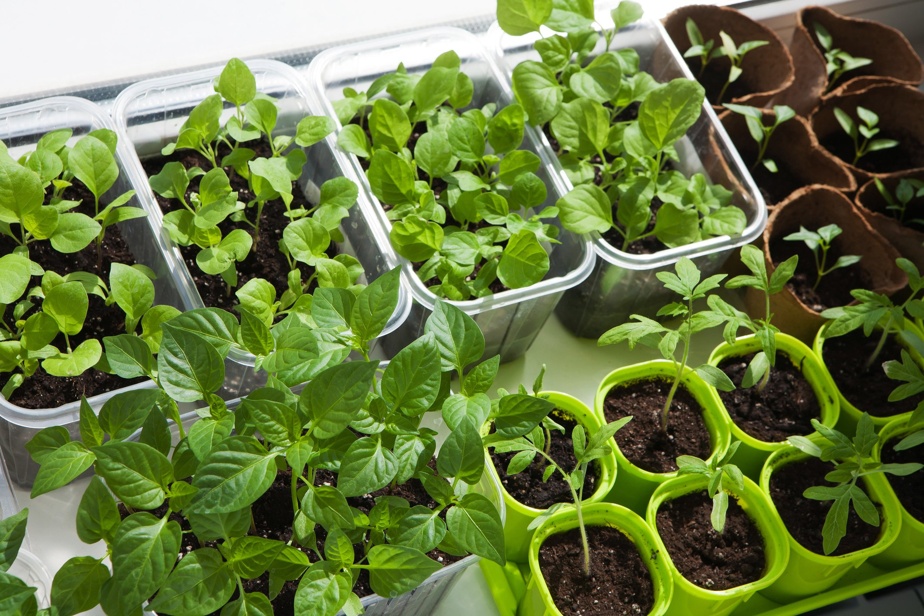
PHOTO PROVIDED BY LES JARDINS DE L’ÉCUMENE
It is rare that the seeds themselves are to blame when the seedlings do not give the expected results.
Control spring fever
Jean-François Lévesque has been producing seeds for years. Co-owner of the famous house Jardins de l’ecumène, in Saint-Damien, in the Lanaudière region, he lists the main factors of seedling failure: lack of light, planting period and method, ventilation. Lisa Birri uses the same language. A member of the famous family of Jean-Talon Market gardeners, she offers heirloom seeds on the Internet. “It’s very rare that seeds are involved,” she says. So when a customer tells me that his seedlings have not given the expected result, that they have withered, for example, I try to find the origin of the problem. Unfortunately, spring fever causes many to act hastily and to make mistakes. »

PHOTO ALAIN ROBERGE, LA PRESSE ARCHIVES
Transplanting can be done as soon as the seedlings show two leaves.
Sowing too early and lack of lighting
Etiolation is primarily attributable to insufficient light, our experts explain. Elongated and stunted, the plant is often doomed to premature death. And if he survives intensive care, the recovery in the vegetable garden will be very difficult and will often not be worth the energy devoted.
The golden rule: it is better to sow later than earlier. The later you sow (early April for many varieties that will need to be transplanted), the longer the days will be and the more your plants will benefit. We recommend 14 hours of light per day, which shows how demanding the seedlings are. The longer they are inside, the greater the risk of etiolation. Growing conditions at home will never equal those prevailing in a greenhouse.
To optimize your chances of success, it is always preferable and often essential to use an artificial lighting system.
The planting method is also important. Too dense, it also promotes etiolation. Moreover, a seed buried too deeply will take a lot of energy to emerge, which will jeopardize its future. Follow the directions on the seed packet to the letter.

PHOTO PIERRE GINGRAS, PRESS ARCHIVES
The mini-greenhouses that are fruit or vegetable trays are ideal for a multitude of seedlings.
A question of ventilation
Damping off is always dramatic. The fungal disease destroys the seedlings as soon as they come out of the ground. We have to start all over again.
A few basic tips: always use potting soil sold for this purpose. Never garden soil. Disinfect any container that has already been used, even fruit and vegetable trays that can be used for this purpose.
Open the dome of your trays or seed kit as soon as the first leaves appear and make sure there is adequate ventilation. According to Jean-François Lévesque, good circulation of ambient air is essential; otherwise, it would be better to use a fan. Once the seedlings are well erected, wait until the surface of the soil is dry before watering again, always gently, or by spraying.

PHOTO IVANOH DEMERS, LA PRESSE ARCHIVES
Avoid peat capsules, as their plastic coating never degrades and is a nuisance in the compost.
A moistened potting soil
It is always best to moisten the soil well before sowing. Lightly press the surface once the seeds are in the ground to ensure perfect contact with the substrate. Then lightly mist the surface of the planting. If the seedbeds allow the seedlings to reach the desired size, transplanting requires a richer substrate, either by adding mycorrhizae or a soil activator to help the plant develop well before it is planted. in the ground in the vegetable garden. Please note: cucurbits (cucumbers, melons, zucchini, squash, etc.) do not tolerate transplanting with difficulty. It is therefore preferable to use a good size biodegradable pot that can be put directly in the ground at the end of May or the beginning of June.
Finally, do not reduce all your efforts to nothing by transplanting your plants too early in the garden or by failing to take a good week to acclimatize them to their new environment, underlines Lisa Birri. Take your pots outside gradually, avoid direct sunlight, windy places and, if necessary, bring your plants indoors if the temperature requires it.
